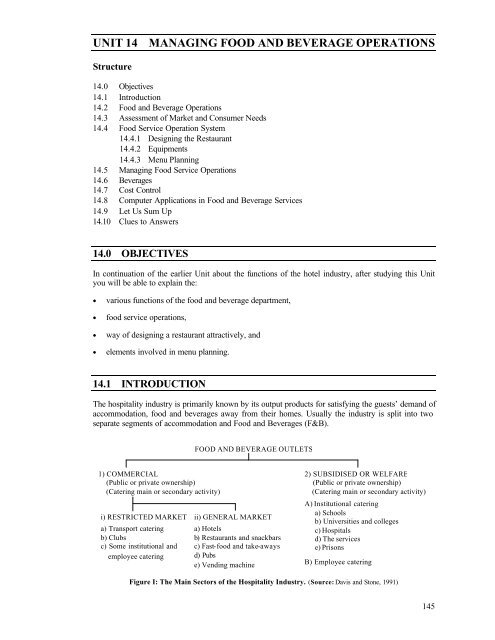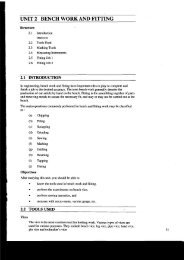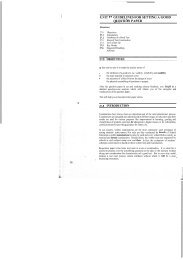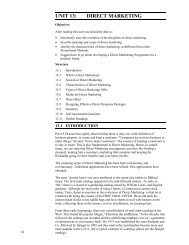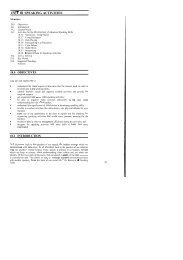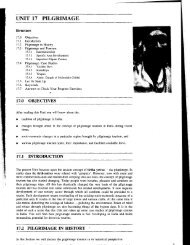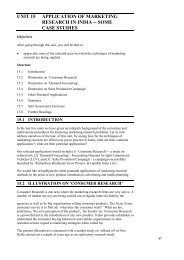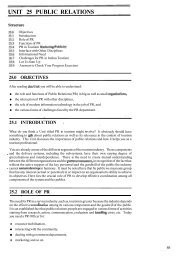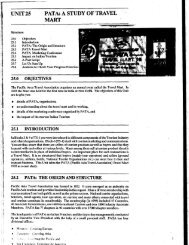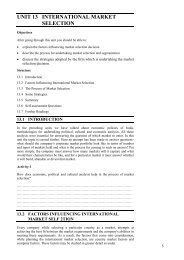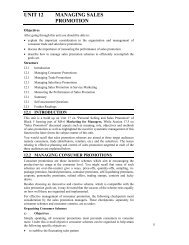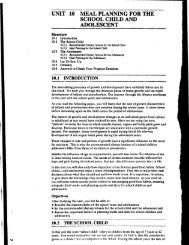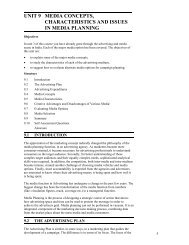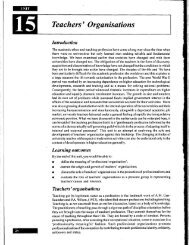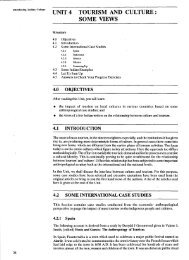unit 14 managing food and beverage operations - eGyanKosh
unit 14 managing food and beverage operations - eGyanKosh
unit 14 managing food and beverage operations - eGyanKosh
Create successful ePaper yourself
Turn your PDF publications into a flip-book with our unique Google optimized e-Paper software.
UNIT <strong>14</strong> MANAGING FOOD AND BEVERAGE OPERATIONS<br />
Structure<br />
<strong>14</strong>.0 Objectives<br />
<strong>14</strong>.1 Introduction<br />
<strong>14</strong>.2 Food <strong>and</strong> Beverage Operations<br />
<strong>14</strong>.3 Assessment of Market <strong>and</strong> Consumer Needs<br />
<strong>14</strong>.4 Food Service Operation System<br />
<strong>14</strong>.4.1 Designing the Restaurant<br />
<strong>14</strong>.4.2 Equipments<br />
<strong>14</strong>.4.3 Menu Planning<br />
<strong>14</strong>.5 Managing Food Service Operations<br />
<strong>14</strong>.6 Beverages<br />
<strong>14</strong>.7 Cost Control<br />
<strong>14</strong>.8 Computer Applications in Food <strong>and</strong> Beverage Services<br />
<strong>14</strong>.9 Let Us Sum Up<br />
<strong>14</strong>.10 Clues to Answers<br />
<strong>14</strong>.0 OBJECTIVES<br />
In continuation of the earlier Unit about the functions of the hotel industry, after studying this Unit<br />
you will be able to explain the:<br />
• various functions of the <strong>food</strong> <strong>and</strong> <strong>beverage</strong> department,<br />
• <strong>food</strong> service <strong>operations</strong>,<br />
• way of designing a restaurant attractively, <strong>and</strong><br />
• elements involved in menu planning.<br />
<strong>14</strong>.1 INTRODUCTION<br />
The hospitality industry is primarily known by its output products for satisfying the guests’ dem<strong>and</strong> of<br />
accommodation, <strong>food</strong> <strong>and</strong> <strong>beverage</strong>s away from their homes. Usually the industry is split into two<br />
separate segments of accommodation <strong>and</strong> Food <strong>and</strong> Beverages (F&B).<br />
1) COMMERCIAL<br />
(Public or private ownership)<br />
(Catering main or secondary activity)<br />
i) RESTRICTED MARKET<br />
a) Transport catering<br />
b) Clubs<br />
c) Some institutional <strong>and</strong><br />
employee catering<br />
FOOD AND BEVERAGE OUTLETS<br />
ii) GENERAL MARKET<br />
a) Hotels<br />
b) Restaurants <strong>and</strong> snackbars<br />
c) Fast-<strong>food</strong> <strong>and</strong> take-aways<br />
d) Pubs<br />
e) Vending machine<br />
2) SUBSIDISED OR WELFARE<br />
(Public or private ownership)<br />
(Catering main or secondary activity)<br />
A) Institutional catering<br />
a) Schools<br />
b) Universities <strong>and</strong> colleges<br />
c) Hospitals<br />
d) The services<br />
e) Prisons<br />
B) Employee catering<br />
Figure I: The Main Sectors of the Hospitality Industry. (Source: Davis <strong>and</strong> Stone, 1991)<br />
<strong>14</strong>5
There are various kinds of <strong>food</strong> <strong>and</strong> <strong>beverage</strong> <strong>operations</strong> designed to meet the dem<strong>and</strong> of the<br />
consumers. Over the years, eating out has become a matter of choice rather than necessity. However,<br />
the primary reasons for eating out are:<br />
• to celebrate a special occasion or treat,<br />
• meeting friends,<br />
• just for a change from home, <strong>and</strong><br />
• at times a necessity, e.g., eating out while travelling.<br />
In this Unit thus, you will be familiarised with the working of the Food <strong>and</strong> Beverage outlets.<br />
Primarily, you will learn about opening <strong>and</strong> <strong>managing</strong> of a <strong>food</strong> <strong>and</strong> <strong>beverage</strong> outlet irrespective of its<br />
location <strong>and</strong> speciality.<br />
<strong>14</strong>.2 FOOD AND BEVERAGE OPERATIONS<br />
Food <strong>and</strong> <strong>beverage</strong> segment of hospitality industry is primarily concerned with providing <strong>food</strong> <strong>and</strong><br />
<strong>beverage</strong>s to their consumers. Various elements related in it’s <strong>operations</strong> can be summarised in the<br />
catering cycle which is shown in Figure II.<br />
<strong>14</strong>6<br />
(h) Monitoring of consumer satisfaction<br />
(g) Control of costs <strong>and</strong> revenues<br />
(f) Production <strong>and</strong> service<br />
Figure II: The Catering Cycle (Source: Cracknell et al., 1983)<br />
The fact that the catering cycle is not only concerned with <strong>operations</strong> but it is also a dynamic model in<br />
the sense that any one problem in one section of the cycle will caus e difficulties for other elements of<br />
the cycle. For example, problem in the purchase section will also affect production <strong>and</strong> service, while<br />
improper utilisation of raw materials during production would also affect control system <strong>and</strong> so on.<br />
We can infer from the cycle that an ideal <strong>food</strong> <strong>and</strong> drink service would be one which:<br />
• provides <strong>food</strong> <strong>and</strong> drink on dem<strong>and</strong>;<br />
(a) Consumer <strong>and</strong> market<br />
(e) Provisioning<br />
• has optimum utilisation of labour <strong>and</strong> skill, raw materials <strong>and</strong> equipments;<br />
• has quick <strong>and</strong> simple methods of operational design; <strong>and</strong><br />
• has flexible system design allowing ease of adaptation.<br />
(b) Formulation of policy<br />
(c) Interpretation of dem<strong>and</strong><br />
(d) Convergence of facilities<br />
To be able to establish <strong>and</strong> manage such an ideal <strong>food</strong> <strong>and</strong> <strong>beverage</strong> outlet one would require<br />
meticulous preparation, both at pre <strong>and</strong> post opening stages of the outlet. Yet the common assumption<br />
is that Food <strong>and</strong> Beverage outlet is the easiest way to earn a profit, since <strong>food</strong> always sells. It is also<br />
often assumed that if you eat well then you know how to run an eating joint. Well such thoughts are<br />
far from the truth. Let us now discuss various elements involved in the opening <strong>and</strong> running of a<br />
restaurant successfully.
<strong>14</strong>.3 ASSESSMENT OF MARKET AND CONSUMER NEEDS<br />
Market research should be the first activity to be performed once you decide to open <strong>food</strong> <strong>and</strong><br />
<strong>beverage</strong> outlet. Figure III displays how you can decide upon creating a product based on the<br />
consumer needs.<br />
Market Research<br />
Market Segmentation<br />
Idea Evaluation<br />
Concept Development<br />
Product Development<br />
Create Product-Consumer Relationship<br />
Figure III: Product-consumer Relationship Development Framework<br />
Market research requires investment of a lot of time <strong>and</strong> money. The methods used can be interviews,<br />
questionnaires, sales analysis, consumer panels, market information from specialises publications,<br />
specifically commissioned market information <strong>and</strong> other data available ordinarily. Large organisations<br />
try out all the avenues of market research while smaller outlets may perform their market research on<br />
their own. Market research is, therefore, concerned with human needs, wants, dem<strong>and</strong>s, goals <strong>and</strong><br />
values.<br />
Market research paves the way for market segmentation <strong>and</strong> the identification of the target consumers.<br />
As you know market segmentation can be demographic, geographic or others. You should know that<br />
the same product belonging to an international <strong>food</strong> chain can be priced differently in different<br />
countries.<br />
Idea generation can be a brainstorming session or it can be based on the market research reports. It<br />
would be focussed on generating a product based on consumer needs, wants <strong>and</strong> dem<strong>and</strong>s. The<br />
generated ideas need to be screened. The type of outlet to the type of <strong>food</strong> that would be served needs<br />
to be generated <strong>and</strong> screened during this session.<br />
Once an idea has passed the screening process, various products <strong>and</strong> parts of products need to be<br />
conceptualised. Various factors like price, quantity, amount of choice; consumer’s quality perceptions<br />
<strong>and</strong> amount of product usage are used to position a conc ept. Once the idea is converted into a concept<br />
it needs to be tested in the identified market segment. Questionnaires <strong>and</strong> interviews regarding the<br />
conceptualised product, its price <strong>and</strong> location of outlet, etc. answered by the prospective clients would<br />
help in finalising the product(s).<br />
Product Development Stage would involve turning this concept into a product. Food <strong>and</strong> Beverage<br />
products do not only mean providing <strong>food</strong> <strong>and</strong> drink but also involves decisions on the type of service<br />
outlet to be provided, the kind of service whether a self-serving or speciality restaurant or a take-away<br />
meal outlet would also help in forming the complete product. It is essential to underst<strong>and</strong> how we<br />
would like the consumers to view our outlet. The way we would want the consumers to view our<br />
<strong>14</strong>7
outlet whether a Gourmet event or cheap meal outlet, etc. would define the ambience, price, service<br />
<strong>and</strong> <strong>food</strong> <strong>and</strong> <strong>beverage</strong>. Once we are definite on our product we need to launch our product with right<br />
promotion so as to reach our target consumers.<br />
The consumer-product relationship, once built, needs to be maintained <strong>and</strong> improved upon. However,<br />
with the passage of time the needs, wants <strong>and</strong> dem<strong>and</strong>s of the consumer change. Therefore, market<br />
research should be an ongoing procedure to ensure a long lasting relationship with the consumer. In<br />
other words, feedback is necessary to maintain the old consumer relationships <strong>and</strong> to form new ones.<br />
<strong>14</strong>.4 FOOD SERVICE OPERATION SYSTEM<br />
Food Service Operations involve the procuring of raw materials, production of <strong>food</strong> <strong>and</strong> finally<br />
serving to the customers on dem<strong>and</strong>. As the <strong>food</strong> service outlet varies, the type of services provided<br />
<strong>and</strong> also the <strong>food</strong> production process also varies. Yet the process can be depicted simply as,<br />
The input being the raw materials, processing involving the cooking <strong>and</strong> preparation of <strong>food</strong> <strong>and</strong><br />
output is to serve the prepared <strong>food</strong> to the guests. The process of the <strong>food</strong> production traditionally<br />
followed is depicted in Figure IV.<br />
<strong>14</strong>8<br />
INPUT PROCESSES OUTPUT<br />
Store Prepare<br />
Hold<br />
Cook<br />
Dish wash<br />
Interface between<br />
back -of-house <strong>and</strong><br />
front -of-house<br />
Figure IV: Flow diagram of traditional <strong>food</strong>service delivery systems.<br />
(Source: Adapted from Alan Huelin <strong>and</strong> Peter Jones, Food Service Systems: Generic Types,<br />
Alternative Technology <strong>and</strong> Infinite Variation, Journal Of Foodservice Systems, 5(4), p. 303, 1990)<br />
Figure IV shows the eight distinct stages of the traditional <strong>food</strong> service delivery system. These stages<br />
are:<br />
1) Storage – refrigerated or ambient storage of material<br />
2) Preparation – activities such as peeling, cutting <strong>and</strong> so forth<br />
3) Production (cooking) – methods such as frying, roasting <strong>and</strong> so forth<br />
4) Holding – storage between production <strong>and</strong> consumption<br />
5) Service – style of delivering dishes/meals to consumers<br />
6) Dining – consumption of meal by consumer in setting<br />
7) Clearing – removal of equipment/<strong>food</strong> debris<br />
8) Dish wash – cleansing of soiled equipment<br />
A few distinguishing features of the traditional system are:<br />
• Clear demarcation between front <strong>and</strong> back of the house,<br />
• Customer interaction/contact is restricted only to the front, <strong>and</strong><br />
• All the activities take place on the same premises.<br />
Serve Dine Clear
Various modern <strong>food</strong> service outlets do not always follow the traditional system in it’s true form. A<br />
few changes are brought about, depending on the type of service outlet. For example, a la carte<br />
restaurant in a five star hotel would use fresh ingredients <strong>and</strong> stage 4, wherein prepared <strong>food</strong>s are kept<br />
on hold is not necessary. Same is the case when in speciality restaurant the different courses are<br />
prepared right in front of the guest. At times the prepared <strong>food</strong> needs to be held in special temporary<br />
conditions <strong>and</strong> so on. Thus, the <strong>food</strong> production process is modified according to the policy of the<br />
outlet.<br />
The production policy decides the purchasing <strong>and</strong> storing factors. The success of the outlet depends as<br />
much on the <strong>food</strong> production processes as on the site <strong>and</strong> décor of the place. Initially the idea of<br />
opening a distinctive type of service outlet is decided for example a bar or restaurant with self -serving<br />
facilities, etc. Then a site is selected according to the distance from the target market. Often a new<br />
restaurant is opened within an existing hotel. A manager takes decisions of opening new eating joints<br />
as a result of the changing markets trends or a dem<strong>and</strong> of a new outlet by the guests visiting the hotel.<br />
The opening of a new outlet within a hotel means to create space within the area by either renovating<br />
an old eating joint or otherwise. Once the space has been earmarked, one can start working for setting<br />
up <strong>and</strong> running the outlet. This also involves designing of the Restaurant, i.e., the designing of both<br />
the sitting area <strong>and</strong> the kitchen <strong>and</strong> office area for such an outlet.<br />
<strong>14</strong>.4.1 Designing the Restaurant<br />
The designing of the sitting area of restaurant depends on the type of restaurant. For example, if the<br />
restaurant is only for breakfast buffet, then the sitting arrangements needs to be centred around or near<br />
the buffet table for easy access by the customers. While designing the guest sitting area one needs to<br />
choose the correct furnishing <strong>and</strong> furnitures. The guest sitting area should provide some form of<br />
privacy to each guest table <strong>and</strong> at the same time have optimum utilisation of space. Each table should<br />
be easily accessible by the serving staff <strong>and</strong> thus save on serving time. The décor should be pleasant<br />
as well as attractive. The ambience of the restaurant contributes towards the customer satisfaction.<br />
Over-doing the décor is not advisable. Lighting plays an important role for giving the correct<br />
ambience, but one should remember there’s a difference between deductive lighting <strong>and</strong> eating one’s<br />
meal in almost total darkness. Soft music, if played completes the relaxed ambience <strong>and</strong> environment.<br />
Air conditioning, though not a must a few years back, has now become a necessity so as to provide<br />
clean <strong>and</strong> cool air to the guests.<br />
Designing the kitchen also forms an important part since major work is done there. The primary areas<br />
of kitchen can be distinguished as:<br />
a) Storage: where the raw materials are stored. This would mean both dry storage <strong>and</strong> refrigerated<br />
storage area. Storage area is also dependent on the type of restaurant. For example, a speciality<br />
restaurant may require some special storage facilities for the ingredients.<br />
b) Pre-preparation Area: Kitchen usually has a specified area for cleaning, peeling, chopping,<br />
mixing <strong>and</strong> combining ingredients.<br />
c) Production Areas: The production areas or <strong>food</strong> preparation area is best situated. The production<br />
area has hot <strong>food</strong> <strong>and</strong> cold <strong>food</strong> area wherein main courses, soups <strong>and</strong> salads <strong>and</strong> other<br />
refrigerated <strong>food</strong> is prepared, respectively.<br />
d) Bakery: If the manager decides on providing baked <strong>food</strong>, a separate bakery is useful.<br />
e) Holding <strong>and</strong> Service: An area for holding the <strong>food</strong> prior to service is very essential.<br />
f) Ware Washing: The washing area is usually near to the dining area but also close to the main<br />
production area.<br />
g) Pot <strong>and</strong> Pan Area: A pot <strong>and</strong> pan area would enable the storing of the utensils when they are not<br />
in use.<br />
The restaurant design must have an Office Area <strong>and</strong> Employees Area. The office area would be used<br />
to keep the record of various transactions both with the suppliers <strong>and</strong> the consumers. The employees<br />
need an area to change into work clothes <strong>and</strong> also an area to rest during breaks. It’s the manager’s<br />
duty to check the viability of a restaurant’s final design <strong>and</strong> work out the viability of the plan.<br />
<strong>14</strong>9
<strong>14</strong>.4.2 Equipments<br />
The general points to be considered when purchasing equipment for a <strong>food</strong> <strong>and</strong> <strong>beverage</strong> service area<br />
are (Source: Food <strong>and</strong> Beverage Management by Cousins, Foskett <strong>and</strong> Shortt):<br />
• Flexibility of use;<br />
• Type of service being offered;<br />
• Type of customer;<br />
• Design;<br />
• Colour;<br />
• Durability;<br />
• Ease of maintenance;<br />
• Stakability;<br />
• Costs <strong>and</strong> funds available;<br />
• Availability in the future – replacements;<br />
• Storage;<br />
• Rate of breakage, e.g., for China;<br />
• Shape;<br />
• Psychological effect on guests; <strong>and</strong><br />
• Delivery time.<br />
When purchasing China factors to be considered are:<br />
• Every time of earthenware should have a complete cover of glaze to ensure a reasonable length of<br />
life;<br />
• China should have a rolled edge which will give added reinforcement at the edge; <strong>and</strong><br />
• The pattern should be under rather than top of the glaze. However, this dem<strong>and</strong>s additional glaze<br />
<strong>and</strong> firing. Patterns on the top of the glaze will wear <strong>and</strong> discolour very quickly. Therefore, China<br />
with the pattern under the glaze is more expensive but its life will be longer.<br />
Tableware is a term which includes:<br />
• Flatware: all forms of spoons <strong>and</strong> forks;<br />
• Cutlery: knives <strong>and</strong> other cutting equipments; <strong>and</strong><br />
• Hollow-ware: any item made from silver, apart from flatware <strong>and</strong> cutlery, e.g., teapots, milk jugs,<br />
sugar basins, oval flats.<br />
The majority of <strong>food</strong> service areas use either plated silverware or stainless steel. Checking the quality<br />
<strong>and</strong> grade of the plated silverware along with the degree of stainless steel polishing is a must before<br />
buying them.<br />
Glassware contributes to the appearance of the table <strong>and</strong> the overall attraction of the room. Most of<br />
the manufacturers now supply hotel glassware in st<strong>and</strong>ard sizes for the convenience of ordering,<br />
availability <strong>and</strong> quick delivery. Except in certain speciality restaurants or high-class establishments,<br />
where either coloured glassware or cut glassware may be used, hotel glassware is usually plain.<br />
150
Other than above service ware pots <strong>and</strong> pans along with various electronic gadgets need to be bought<br />
for the kitchen. Food processing is possible only if the correct <strong>and</strong> easy to use utensils are available<br />
for the same. Also service linen need to be purchased. The service linen are needed for the tables as<br />
well as trolleys <strong>and</strong> sideboard cloth. Tea <strong>and</strong> glass cloth <strong>and</strong> table napkins are also used but the quality<br />
of linen varies as the use varies.<br />
<strong>14</strong>.4.3 Menu Planning<br />
Consumers’ <strong>food</strong> prefer ences are the major factor while deciding upon the menu planning. It is not<br />
easy to decide what will most be liked by the people. The consumer preferences are based on many<br />
factors, such as, <strong>food</strong>, nutritional value, the cultural <strong>and</strong> ethnic background <strong>and</strong> others.<br />
Figure V (Source: VNR’s encyclopaedia) brings forth the factors affecting <strong>food</strong> habits, acceptance <strong>and</strong><br />
preference.<br />
Level of Expectation<br />
Priority – Familiarity<br />
Influence of Others<br />
Personality, Moods<br />
Appetites, Emotions<br />
Family<br />
Education<br />
Preparation Methods<br />
Organoleptic<br />
Characteristics<br />
Appearances, Texture<br />
Temperature<br />
Colour, Odour, Flavour,<br />
Quality<br />
Biological: Sex-Age<br />
Physiological:<br />
Changes Condition<br />
Psych: Influences<br />
FOOD HABITS<br />
ACCEPTANCES<br />
PREFERENCES<br />
Religious Restrictions<br />
Traditions<br />
Cultural influences<br />
Environmental<br />
Situational<br />
Advertisement<br />
Seasonal Variation<br />
Economic Conditions<br />
Food Costs<br />
Security – Past Habits<br />
Conformity<br />
Prestige<br />
Figure V: Factors affecting <strong>food</strong> habits, acceptance, <strong>and</strong> preferences<br />
Figure V clearly illustrates that the <strong>food</strong> habit acceptances <strong>and</strong> preferences depend on the fo llowing<br />
factors:<br />
• Age, sex, physiological <strong>and</strong> psychological influence affect of the <strong>food</strong> a consumer chooses,<br />
151
• Factors like appetite, personality, mood <strong>and</strong> emotions <strong>and</strong> also the influence of other people,<br />
• Advertising <strong>and</strong> environmental situations prevalent even before the guest enters the restaurant,<br />
• Economic conditions <strong>and</strong> social or prestige issue of the guest,<br />
• The appearance, texture, quality, odour <strong>and</strong> flavour of the prepared <strong>food</strong>, <strong>and</strong><br />
• Finally, religious <strong>and</strong> cultural constraints as many people don’t try some <strong>food</strong> due to their set<br />
views.<br />
As you can see many factors affect the <strong>food</strong> preferences <strong>and</strong> most of them are beyond the control of<br />
F&B Manager. It is difficult to be 100% sure what is going to appeal to the consumer. Thus, menu<br />
planning is extremely important since it involves selection of <strong>food</strong>, <strong>and</strong> <strong>beverage</strong>s acceptable to both –<br />
to the guests (consumers) <strong>and</strong> to the management. Menu planning involves careful consideration of<br />
the following aspects:<br />
• The type of <strong>food</strong> service outlet <strong>and</strong> the budget available with the organisation for the outlet;<br />
• The consumer <strong>food</strong> habits;<br />
• The availability of the raw materials is also important. Many <strong>food</strong> items are seasonal <strong>and</strong><br />
procuring of exotic ingredients can prove to be difficult. The viability of the menu depends on the<br />
available ingredients; <strong>and</strong><br />
• The physical facilities <strong>and</strong> equipments also dictate menu planning. Both the type <strong>and</strong> number of<br />
equipments available play an important role in the selection of menu items.<br />
Once the factors affecting menu planning are understood, menu is decided upon. Essentially menus<br />
can be of three types:<br />
a) Static or fixed menu where the same menu items are offered repeatedly.<br />
b) Cycle menu refers to menus, offering different items for a pre-determined time period.<br />
c) Finally, Single Use Menus which are planned only for special days or occasions <strong>and</strong> are not<br />
repeated.<br />
Cookbooks <strong>and</strong> computers help to a greater extent in Menu planning. The success or failure of a <strong>food</strong><br />
service venture depends on the menu <strong>and</strong> hence Menu is the focal point around which all the<br />
components of a <strong>food</strong> service operation are centred.<br />
<strong>14</strong>.5 MANAGING FOOD SERVICE OPERATIONS<br />
As a manager you need to concentrate on the management aspect of <strong>food</strong> services once your outlet is<br />
operational. Various aspects of <strong>managing</strong> <strong>food</strong> service <strong>operations</strong> involves:<br />
a) Food Purchasing:<br />
152<br />
According to John Stefanelli the <strong>food</strong> service purchasing involves:<br />
• developing specifications;<br />
• preparing an approved suppliers list;<br />
• determining the appropriate order size; <strong>and</strong><br />
• establishing appropriate receiving <strong>and</strong> storage procedures.<br />
Specifications is the first step, since it represents cost <strong>and</strong> quality control guidelines.<br />
Developing appropriate specifications for each item purchased from an outside supplier helps in<br />
avoiding any future misunderst<strong>and</strong>ing among the concerned people. Mostly the restaurant
manager’s develop an approved supplier’s list. This ensures a consistency in quality <strong>and</strong> cost.<br />
This also helps in controlling the buyer’s activities. Usually, the manager can only add or delete a<br />
supplier’s name to the list. Determining the order size is very difficult. A case of over-buy results<br />
in storage problem whereas under-buy is an option no manager wants to take. Over a period of<br />
time a somewhat accepted order size could be agreed upon.<br />
Once needs are determined, the procedure for ordering <strong>and</strong> buying is set up. Invoices <strong>and</strong> receipts<br />
with signatures will help in checking any possible mischief or theft.<br />
b) Managing <strong>food</strong> production systems:<br />
Food production is the core of the <strong>food</strong> service industry. Menu classification starts the <strong>food</strong><br />
production system Table 1 describes. The three different types of menus which are mainly used<br />
according to the nature of outlet.<br />
Table 1: Menu classification<br />
No Choice Limited Choice Choice<br />
Fixed (static) Quick-service restaurant Full service restaurant<br />
Cafeteria<br />
Cycle Airline<br />
Nursing home<br />
School <strong>food</strong>-service Cafeteria<br />
Single-use Banquet Catered luncheon Buffet<br />
Although menu forms the core of <strong>food</strong> service industry, the ingredients form the magic part of the<br />
<strong>food</strong> produced. Herein, comes the usefulness of recipe st<strong>and</strong>ardisation. It is the most important<br />
tool available to control costs <strong>and</strong> ensure product consistency <strong>and</strong> quality. Consistence duplication<br />
of <strong>food</strong> item is achieved with an accurate record of ingredients, amounts <strong>and</strong> methods of<br />
combining ingredients <strong>and</strong> cooking. Given below in Table 2 is a format used for st<strong>and</strong>ardisation<br />
of recipe:<br />
Date<br />
Meal<br />
Unit<br />
Table 2: Sample production schedule format<br />
Item/Recipe Quantity Needed Actual Produced Time Leftover Comments<br />
Additional instructions<br />
Although st<strong>and</strong>ardisation of a recipe is important, it is often overlooked in <strong>food</strong> service industry.<br />
As a manager, you shall ensure that st<strong>and</strong>ardisation of a recipe is achieved so as to control<br />
quantity <strong>and</strong> quality along with the costs involved in running an eating joint.<br />
c) Food Service Hygiene:<br />
Hygiene is very important for any eating joint. Reputation of a restaurant is made based on its<br />
menu <strong>and</strong> hygiene. Here the employees are in constant contact with <strong>food</strong> <strong>and</strong> preparation<br />
equipment. Major source of contamination of <strong>food</strong> arises from human contact from elements like<br />
skin, fingernails, hair, jewellery, mouth, nose <strong>and</strong> respiratory tract <strong>and</strong> eyes. Employees,<br />
therefore, should be trained to ensure that they maintain personal hygiene.<br />
Next area of consideration is the equipment to be used. The cleaning area should be clean so as to<br />
ensure <strong>food</strong> service hygiene. The sink <strong>and</strong> work surfaces should be cleaned before <strong>and</strong> after every<br />
use. The equipments should be sanitised <strong>and</strong> sterilised after every cleaning. These sterilised<br />
equipments need to be stored in a clean area with protection from splash, dust <strong>and</strong> contact with<br />
<strong>food</strong>. Various sanitation methods like thermal <strong>and</strong> chemical sanitation methods among others<br />
should be used.<br />
The kitchen area <strong>and</strong> dining space should be pest free. Pests like, mice, cockroaches, etc. bring<br />
bad reputation to a place because they are carrier of many diseases. Hence, regular pest control<br />
153
methods must be undertaken so as to ensure hygenity of not only <strong>food</strong> but also of the<br />
surroundings.<br />
<strong>14</strong>.6 BEVERAGES<br />
Beverages or drinks can be either alcoholic or non-alcoholic. Non-alcoholic <strong>beverage</strong>s include tea,<br />
coffee, juices, shakes, aerated drinks <strong>and</strong> of course mineral water. The entire <strong>food</strong> service outlet<br />
usually provides non-alcoholic <strong>beverage</strong>. However, a few offer alcoholic <strong>beverage</strong>s bearing in mind<br />
that:<br />
• special permit or licence is required to serve alcohol at the premises,<br />
• usually specific hours are maintained, <strong>and</strong><br />
• age of the consumer needs to be checked so as to ensure the legal age of buying an alcoholic<br />
drink.<br />
Once an establishment starts to supply or provide alcoholic drinks to the consumers it needs to<br />
maintain a wine <strong>and</strong> drinks list. If the drinks are served along with <strong>food</strong> then the list should match the<br />
<strong>food</strong> on the menu. The drink list is provided to the guests along with <strong>food</strong> menu <strong>and</strong> the drink should<br />
help bring out the flavour of the <strong>food</strong>. For example, white wine goes well with less flavoured <strong>food</strong> <strong>and</strong><br />
so on. The list size <strong>and</strong> shape should be such that it is easy to h<strong>and</strong>le by both staff <strong>and</strong> guests.<br />
Types of Wine <strong>and</strong> Drinks List<br />
The wine <strong>and</strong> drink contents of a list may include (Source: Food <strong>and</strong> Beverage Management by Cousins, Foskett<br />
<strong>and</strong> Shortt):<br />
• non-alcoholic drinks including natural spring <strong>and</strong> mineral waters, aerated waters, squashes, juices<br />
<strong>and</strong> syrups.<br />
• cocktails including non-alcoholic cocktails,<br />
• bitters as aperitifs <strong>and</strong> for mixed drinks <strong>and</strong> cocktails,<br />
• wines including still wine, sparkling wines, alcohol-free, de-alcoholised <strong>and</strong> low-alcohol wines,<br />
fortified wines <strong>and</strong> aromatised wines,<br />
• spirits,<br />
• liqueurs,<br />
• beers including draught <strong>and</strong> packaged beers <strong>and</strong> reduced alcohol beers, <strong>and</strong><br />
• cider <strong>and</strong> perry.<br />
The order of wines <strong>and</strong> drinks on a list tends to follow the order of consumption or be grouped under<br />
types of wine or drink.<br />
• Cocktails,<br />
• Aperitifs,<br />
• Cups,<br />
• Wines,<br />
• Liqueurs, <strong>and</strong><br />
• Beers, minerals <strong>and</strong> squashes.<br />
Wines are often listed by area, with the white wines of one region first followed by the red wines of<br />
that region. A more modern trend is to list all the white wine available area by area followed by the<br />
red wines arranged in a similar way. This type of layout is often more useful to the customer.<br />
154
However, in all wine lists sparkling wines, <strong>and</strong>, therefore, the champagnes, are often listed before all<br />
other wines available.<br />
These may range from a basic st<strong>and</strong>ard list offering the common everyday aperitifs, a selection of<br />
spirits with mixers, beers <strong>and</strong> soft drinks together with a limited range of cocktails to a very<br />
comprehensive list offering a wide choice in all areas:<br />
• A full <strong>and</strong> very comprehensive list of wines from all countries, but emphasis on the classic areas<br />
such as Bordeaux/Burgundy plus a fine wine/prestige selection,<br />
• A middle of the road traditional selection, e.g., some French, German, Italian together with some<br />
‘New World’ wines,<br />
• A small selection for well-known or br<strong>and</strong>ed wines – a prestige list, <strong>and</strong><br />
• Predominantly wines of one specific country.<br />
After-meal drinks list (digestifs)<br />
• These are often combined with the wine list – although are occasionally presented as a separate<br />
liqueur list,<br />
• The list should offer a range of liqueurs together with possibly a specialist range of br<strong>and</strong>ies<br />
<strong>and</strong>/or a specialist range of malt whiskies. Vintage <strong>and</strong> LBV port may also be offered here, <strong>and</strong><br />
• A range of speciality liqueur/spirit coffees might also be included.<br />
Banqueting wine lists<br />
• The length is generally according to size <strong>and</strong> style of operation,<br />
• In most instances there is a selection of popular wine names/styles on offer,<br />
• There would be a range of prices from house wines to some fine wines to suit all customer<br />
preferences, <strong>and</strong><br />
• In some instances the banqueting wine will draw wines from the restaurant wine list.<br />
Room service drinks list<br />
• There may be a mini-bar or choice from a st<strong>and</strong>ard bar list, <strong>and</strong><br />
• They usually offer a limited range of wines.<br />
Purchasing <strong>and</strong> Pricing<br />
Purchas ing the right amount of stock is the main objective of a <strong>beverage</strong> manager. Many items have<br />
limited shelf life but in the case of good wine it can be decades. Nevertheless, under -stocking means<br />
not being able to serve the guests properly while over stocking means extra storage space. The right<br />
stock levels can be determined by using past sales data. A formula which can also be useful is:<br />
M = W (T + L) + S<br />
(Source: Food <strong>and</strong> Beverage Management by Cousins, Foskett <strong>and</strong> Shortt)<br />
where<br />
M is the maximum stock,<br />
W is the average usage rate,<br />
T is the review period,<br />
L is the lead time,<br />
S is the safety stock (buffer or minimum).<br />
155
An example of using this formula could be<br />
W = 24 bottles per week<br />
T = 4 weeks<br />
L = 1 week<br />
S = 1 week’s usage, i.e., 24 bottles.<br />
Therefore,<br />
ROL (Reorder Level) may also be calculated as:<br />
The Pricing is based on three basic methods:<br />
156<br />
M = 24 (4 + 1) + 24 = <strong>14</strong>4 bottles<br />
(W × L) + S = (24 × 1) + 24 = 48 bottles<br />
1) Cost Plus Pricing: The selling price is determined by the addition of specific percentage, of the<br />
cost price, to the cost of the drink (Gross profit = sales less the cost of sales).<br />
2) Rate of Return: The total costs of the business are determined for a given business level <strong>and</strong><br />
from this the percentage of the cost price required to be added to the cost is determined in order to<br />
ensure that business will be viable.<br />
3) Market Oriented: Selling price is determined by considering both what the customer is likely to<br />
pay as well as what others in similar <strong>operations</strong>, locally, are charging.<br />
Storage <strong>and</strong> Cellar Management<br />
Factors <strong>and</strong> practices which determine good cellar management are (Source: Food <strong>and</strong> Beverage<br />
Management by Cousins, Foskett <strong>and</strong> Shortt):<br />
• Good ventilation,<br />
• High levels of cleanliness,<br />
• Even temperatures of 13-15 o C (55-59 o F),<br />
• Strong draughts <strong>and</strong> wide ranges of temperatures should be avoided,<br />
• On delivery all casks should be placed immediately upon the stillions,<br />
• Casks remaining on the floor should have the bung uppermost to withst<strong>and</strong> the pressure better,<br />
• Spiling should take place to reduce any excess pressure in the cask,<br />
• Tappings should be carried out 24 hours before a cask is required,<br />
• Pipes <strong>and</strong> engines should be cleaned at regular intervals,<br />
• Beer left in pipes after closing time should be drawn off,<br />
• Returned beer should be filtered back into the cask from which it came,<br />
• Care should be taken that the cellar is not overstocked,<br />
• All spiles removed during the service should be replaced after closing time,<br />
• All cellar equipment should be kept scrupulously clean,
• Any ullage should be returned to the brewery as soon as possible, <strong>and</strong><br />
• All beer lines should be cleaned weekly with a diluted pipe-cleaning fluid <strong>and</strong> the cellar floor<br />
washed down weekly with a weak solution of chloride of lime (mild bleach).<br />
Wines should be located away from excessive heat – hot water pipes, a heating plant or hot <strong>unit</strong>.<br />
Table wines should be stored on their sides in bins so that the wine remains tin contact with the cork.<br />
This keeps the cork exp<strong>and</strong>ed <strong>and</strong> prevents air from entering the wine – a disaster which qu ickly turns<br />
wine to vinegar. White, sparkling <strong>and</strong> rose wines are kept in the coolest part of the cellar <strong>and</strong> in bins<br />
nearest the ground (because warm air rises). Red wines are best stored in the upper bins. There are<br />
also special refrigerators or cooling cabinets for keeping sparkling, white <strong>and</strong> rose wines at serving<br />
temperature.<br />
These may be stationed in the dispense bar – a bar located between the cellar <strong>and</strong> the restaurant – to<br />
facilitate prompt service.<br />
Spirit, liqueurs, beers, squashes, juices <strong>and</strong> mineral waters are usually stored upright in their<br />
containers, as are fortified wines. The exceptions are port-style wines which are destined for laying<br />
down.<br />
Beverage Control<br />
The following factors need to be considered in the <strong>beverage</strong> control (Source: Food <strong>and</strong> Beverage<br />
Management by Cousins, Foskett <strong>and</strong> Shortt):<br />
• The record of the supplier <strong>and</strong> the deliveries received from him,<br />
• A record of movement of stock between bars <strong>and</strong> restaurants,<br />
• A cellar stock ledger to maintain the stock records,<br />
• Requisition form should be used by the <strong>unit</strong>s selling alcoholic <strong>beverage</strong>s to draw items from the<br />
cellar,<br />
• Record of goods received <strong>and</strong> issued from the cellar is to be maintained, <strong>and</strong><br />
• A record of the sales taking place. At the end of the day, auditor can go through all the records<br />
<strong>and</strong> come upon the exact sales <strong>and</strong> profit record.<br />
<strong>14</strong>.7 COST CONTROL<br />
The aim of any business is to make profit. Profit is not only earned but every time one saves money,<br />
money is earned. According to James Keiser, control works best when it is used with other<br />
management processes like planning, organising, directing <strong>and</strong> evaluating. According to him there are<br />
two basic approaches to control – Behaviouristic Approach <strong>and</strong> Traditional Approach. The<br />
traditional approach has two main aspects. One is directing personnel or keeping an eye on things or<br />
management by walking around <strong>and</strong> he or she can correct what is not right or what is cost control<br />
breakdowns. The other aspect of traditional control is measurement of performance with that desired<br />
or deemed attainable. This is the comparison aspect of the management scheme which is usually<br />
considered to have four parts:<br />
1) Establishment of st<strong>and</strong>ards or goals. These can be expressed in different ways, for instance, a<br />
budget figure, a percentage figure, or a performance figure such as meals served per server hour.<br />
Many industry st<strong>and</strong>ards are available for consideration by individual <strong>food</strong> service <strong>operations</strong>.<br />
2) Measurement of performance. There must be some means of measuring performance. Usually it<br />
is a quantitative figure, such as a dollar amount, percentage, or st<strong>and</strong>ard such as meals served per<br />
server hour, that related to st<strong>and</strong>ards.<br />
3) Comparison <strong>and</strong> analysis. Once the st<strong>and</strong>ard or goal has been established <strong>and</strong> actual<br />
performance determined, it is possible to compare the two. The figures will rarely be the same,<br />
157
158<br />
<strong>and</strong> the manager must decide how much variance is acceptable <strong>and</strong> how often the comparisons<br />
should be done or over what time periods.<br />
4) Corrective action. Once a significant variation is determined, the manager must take corrective<br />
action. Such action might involve more observation, personnel changes, or different methods of<br />
<strong>operations</strong>, among many others. Or perhaps the st<strong>and</strong>ard is unrealistic <strong>and</strong> must be changed.<br />
The behaviouristic approach is based on the motivation of people towards the best interest of their<br />
employer. The employers tend to have good relationship with their employees in the <strong>food</strong> service<br />
industry. Yet they feel that the need for traditional control systems is necessary.<br />
Menu pricing is another cost control tool. According to James Kieser factors that need to be<br />
considered in the menu pricing include:<br />
• Elasticity of dem<strong>and</strong>, or whether a change in selling prices will have a significant effect on<br />
customer dem<strong>and</strong>.<br />
• Perception of value, or what a customer perceives the meal or <strong>food</strong> item is worth regardless of<br />
what it costs to produce.<br />
• Effect of competition by which competition can hold selling prices down or lack of competition<br />
can allow higher prices than normal.<br />
• Whether the operation might try to increase profit by using low selling prices to increase volume<br />
or concentrate on higher <strong>unit</strong> profits with fewer <strong>unit</strong> sales.<br />
Besides the menu, the other major costs in <strong>food</strong>service industry include:<br />
a) Purchasing of <strong>food</strong>: As mentioned earlier, the quantity of raw materials ordered should be as<br />
accurate as possible since storage <strong>and</strong> perishability in the nature of <strong>food</strong> materials can be a cause<br />
of loss. Proper inventory of the raw materials in storage will ensure that misuse of stored material<br />
doesn’t happen. Cost materials till the driving experience <strong>and</strong> cleaning of the equipments.<br />
b) Labour Cost: Labour cost is another major cost involved in <strong>food</strong> production. Untrained workers<br />
will tend to cause more harm than good for the restaurant. Having a good Human Resources<br />
policy will ensure that good workers are employed <strong>and</strong> retained by the organisation. Recognition<br />
of labour/personnel needed for a job <strong>and</strong> motivation of personnels will tend to cut costs.<br />
<strong>14</strong>.8 COMPUTER APPLICATIONS IN FOOD AND BEVERAGE<br />
SERVICES<br />
Computers have now become a part <strong>and</strong> parcel of modern society. Application of computers in Food<br />
<strong>and</strong> Beverages <strong>operations</strong> help as:<br />
• It improves guest service,<br />
• Streamlines h<strong>and</strong>ling of paperwork <strong>and</strong> data,<br />
• Improves control over day to day <strong>operations</strong>,<br />
• Generates complete <strong>and</strong> timely reports,<br />
• Reduces costs of paper supplies,<br />
• Increases sales revenue,<br />
• Increases employee productivity,<br />
• Reduces clerical staff,<br />
• Reduction of repetitive tasks <strong>and</strong>
• Helps in maintaining current sales <strong>and</strong> expense data on file.<br />
Selecting a Computer System<br />
You should take your time <strong>and</strong> consider carefully all available options before making a computerinvestment<br />
decision. Some catering executives suggest that you let the following rules guide your<br />
decision.<br />
1) Never be the first user of a computer system. The first user usually is placed in a high-risk<br />
position,<br />
2) Avoid purchasing or leasing a computer system from a firm that has many large clients, unless<br />
you are one of them. The largest users will receive priority service from the computer firm,<br />
3) Before buying a system, always observe someone else using a similar system at a similar hotel<br />
property. Interview the users <strong>and</strong> seek their opinions,<br />
4) Decide specifically what you want the system to do for you. This tells you the type of software<br />
you will need to purchase or rent,<br />
5) Once the software is selected, look for the appropriate hardware. Be certain that the hardware is<br />
compatible with other computer systems used at your property. If possible, never select hardware<br />
that requires you to take data from one machine, reformulate it, <strong>and</strong> enter it into another machine.<br />
Data re-entry tends to reduce significantly the benefits of computerisation, <strong>and</strong><br />
6) Select an adequate computer -service firm. The firm should provide sufficient training <strong>and</strong><br />
technical backup. The company should have a “help hotline”. Furthermore, the firm must be able<br />
to adapt the st<strong>and</strong>ard software to coincide with your property’s overall system.<br />
A good back-up service is important even if the hotel property has computer people on staff. Many<br />
on-site computer people are front office oriented <strong>and</strong> may find your department perplexing.<br />
Computer Uses<br />
Software available to the <strong>food</strong> <strong>and</strong> <strong>beverage</strong> industry can be purchased to perform the following tasks:<br />
1) Desk-top publishing for menus, brochures, <strong>and</strong> other similar promotional materials,<br />
2) Sales analysis,<br />
3) Bookings analysis,<br />
4) Cancellation report,<br />
5) Group-booking long,<br />
6) Daily tracer -list printout of current <strong>and</strong> previous clients,<br />
7) Sales-call report,<br />
8) Group-profile sheet,<br />
9) Banquet event order (BEO),<br />
10) Function resume,<br />
11) Lost-business report,<br />
12) Pre-function sheet,<br />
13) Catering contract,<br />
<strong>14</strong>) Daily event schedule,<br />
15) Forecast,<br />
159
16) Daily function-room schedule,<br />
17) Work schedule,<br />
18) Room layout,<br />
19) Space management,<br />
20) Link to outside suppliers <strong>and</strong> service contractors,<br />
21) Payroll processing,<br />
22) Recipe costing,<br />
23) Menu pricing,<br />
24) Inventory management,<br />
25) Recipe-nutrition analysis,<br />
26) Invoice control,<br />
27) Product-cost analysis,<br />
28) Payroll-cost analysis,<br />
29) Equipment scheduling,<br />
30) Word processing,<br />
31) Time clock,<br />
32) Production schedule,<br />
33) Break-even analysis,<br />
34) Menu planning,<br />
35) Tip reporting,<br />
36) Tip allocation,<br />
37) Server analysis,<br />
38) Stock requisition,<br />
39) Department-by-department comparison,<br />
40) Open-guest-check report,<br />
41) Cashier analysis,<br />
42) Communication with other hotel departments,<br />
43) Link with corporate headquarters,<br />
44) Billing,<br />
45) Inventory reorder, <strong>and</strong><br />
46) Yield management.<br />
Thus, the use of computers in the Food <strong>and</strong> Beverages sector is on the rise. Computerisation has<br />
certainly made things easier for all concerned.<br />
160
Check Your Progress<br />
1) Discuss the product-consumer relationship while developing Food <strong>and</strong> Beverage Operations.<br />
……………………………………………………………………………………………………….<br />
……………………………………………………………………………………………………….<br />
……………………………………………………………………………………………………….<br />
……………………………………………………………………………………………………….<br />
2) Discuss traditional stages of <strong>food</strong> delivery systems.<br />
……………………………………………………………………………………………………….<br />
……………………………………………………………………………………………………….<br />
……………………………………………………………………………………………………….<br />
……………………………………………………………………………………………………….<br />
3) Enlist factors to be considered while purchasing equipments for your restaurants.<br />
……………………………………………………………………………………………………….<br />
……………………………………………………………………………………………………….<br />
……………………………………………………………………………………………………….<br />
……………………………………………………………………………………………………….<br />
<strong>14</strong>.9 LET US SUM UP<br />
Hospitality industry is known for the quality of <strong>food</strong> produced <strong>and</strong> managed through its outlets. We<br />
have a variety of <strong>food</strong> <strong>and</strong> <strong>beverage</strong> op erations designed to meet the dem<strong>and</strong> of the consumer with<br />
diverse needs. It also depends upon the type of outlet you intend to set up. Menu planning will be one.<br />
Once menu planning is accomplished it is vital to complete the range of products on menu. Besides,<br />
equipments used for <strong>food</strong> preparation should be hygienically maintained. Minimum of human touch<br />
shall be allowed so on to minimise the contamination of the <strong>food</strong>. Without <strong>beverage</strong>s <strong>food</strong>s are<br />
incomplete. Beverage, therefore, must be planned in line with kind of <strong>food</strong> been served. Like in any<br />
other industry application of computers have revolutionised the <strong>food</strong> <strong>and</strong> <strong>beverage</strong> <strong>operations</strong> to such<br />
an extent that without computers operators feel h<strong>and</strong>icapped.<br />
Besides the <strong>operations</strong> listed in these Units, today, the hotel industry needs specialists in the areas of<br />
sales <strong>and</strong> marketing, finance, HRD, events <strong>and</strong> conferences, etc. For this you have to go through the<br />
other MTM courses.<br />
<strong>14</strong>.10 CLUES TO ANSWERS<br />
Check Your Progress<br />
1) Refer Sec. <strong>14</strong>.3.<br />
2) Refer Sec. <strong>14</strong>. 4.<br />
3) Refer Sec. <strong>14</strong>.4.<br />
161


